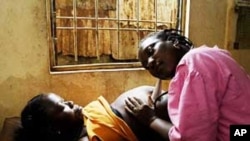Almost 300,000 women, primarily in developing countries, died from complications related to pregnancy and childbirth in 2013 according to a new report that blames the deaths on a lack of safe water, sanitation and adequate hygiene.
A paper published in the journal PLOS Medicine reports that some 38 percent of healthcare facilities in 54 developing countries continue to lack proper sanitation and a source of clean water, putting women who give birth there at increased risk of death.
The article, written by a team of researchers from organizations including WaterAid, the World Health Organization, the London School of Hygiene and Tropical Medicine, UNICEF and the United Nations Population Fund, estimates that 289,000 would-be mothers died from unsanitary conditions, either at home or in healthcare facilities.
Despite 15 years of concerted global efforts to reduce maternal mortality, the report notes it remains 14 times higher in poor countries than developed regions.
Women in unsanitary and unsafe conditions face a high risk of life-threatening infections, according to Oliver Cumming, an environmental health expert at the London School of Hygiene and Tropical Medicine.
He says the risk increases if pregnant women must walk a long distance to obtain clean water or to use a bathroom facility.
“These things produce a range of effects that we don’t necessarily understand but very clearly would bring levels of stress - physical and psychosocial stress - which would pose a risk for the mothers and for the babies," said Cumming.
A companion article in PLOS One describes conditions in Tanzania, where less than one-third of births occur in places with safe water and basic sanitation. Nearly 8,000 women in the East African country die each year, either while giving birth or immediately afterwards.
The United Nations’ eight Millennium Development Goals — which include improving maternal health and reducing child mortality — are winding down next year. To follow up on progress toward the MDGs, world leaders are working the the U.N. to come up with Sustainable Development Goals, which are expected to be adopted in September 2015.
Cumming and his co-authors say providing clean water and sanitation should be at the top of the list of improvements in homes and healthcare facilities in developing countries. He adds that the new goals need to specifically include improved water quality and sanitation as a stand-alone aim with an eye toward improving maternal and newborn health.
“I think it’s a terrible tragedy that women still die during childbirth as a result of the absence of these very basic things being in place, particularly within heath facilitities," he said.
On December 15, nine leading health organizations spearheaded by the London School of Hygiene and Tropical Medicine are issuing a call to action for governments around the world to focus on better water quality, sanitation and hygiene.
The aim is to make greater progress toward improving maternal and neonatal health.








